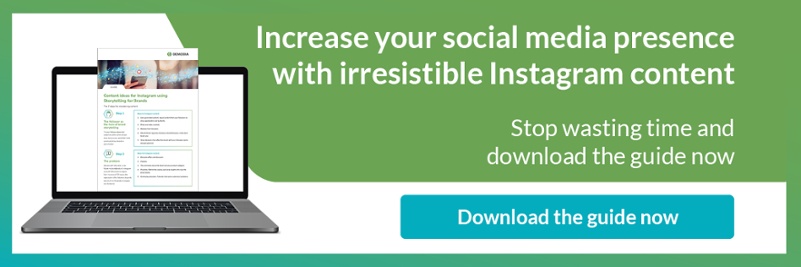The art of storytelling for brands on Instagram: Tips and tricks

When you need to fill your Instagram feed, does panic set in? Your pulse beats faster, your hands feel clammy? Then, when you've spent a lot of thought and time developing relevant content, you realise that your feed comes across as a potpourri of good ideas, but the common thread is missing.
It doesn't have to be.
By following a formula for storytelling for brands you will save yourself time and, as if by magic, each post will tell part of a compelling story - just as the pages of a book make a whole.
The storytelling framework consists of five steps. So let’s show you how to generate relevant content from each stage.
1. The protagonist and his problem
Every story begins with its protagonist. In storytelling for marketing, your customer takes the lead role. He is the centre of your story.
So the customer becomes your protagonist. Now you have to define his problem or challenge. Why do you need a problem?
Without a problem, the protagonist would have no incentive to change anything, to grow as a person or to overcome obstacles. Translated into marketing, this means: Without a problem, the customer has no incentive to buy your product.
Or also: Without a problem, there is no storytelling.
What would Hamlet be without a murdered father and a ghost asking him to take revenge? A Danish prince the world would never have heard of (William Shakespeare, Hamlet).
Frodo Baggins would be a simple hobbit living a quiet life in the Shire if he didn't have to destroy the "One Ring" and save Middle Earth from the darkness of the evil ruler Sauron (J.R.R. Tolkien, Lord of the Rings).
How to turn your customers and their problems into Instagram posts
Use your customers and their problems for your Instagram feed, for example like this:
- Before and after: show the customer problem in a post and present the solution or improvement your brand offers.
Tip: There are many before and after templates on Instagram that allow you to create a before and after reel in less than a minute. - Customer success stories: Share stories or testimonials from satisfied customers who have solved a problem through your brand. Let them describe their experience and the positive impact it had on their day-to-day work.
FAQ: Create a series of Instagram posts answering frequently asked questions about a specific problem or topic. - Expert interviews: Conduct interviews with industry experts or influencers who offer relevant solutions to your customers' problems.
Tip: Go live with them and share excerpts and summaries in your Instagram posts and stories. - Inspirational quotes: Share inspirational quotes that motivate your target audience and help you look at your problems from a different perspective.
Tip: Supplement the quotes with a short comment on how you could tackle the problem. - Live demonstrations: Conduct live demonstrations of how your brand solves a customer's problem.
Tip: Answer followers' questions during the live stream. - Comparative analyses: Compare different solutions or approaches to a problem. Explain the advantages and disadvantages of each option and offer your followers help in deciding.
2. Your brand as the guide
Your role in storytelling for brands is that of guide and mentor. You are Gandalf, the powerful wizard and mentor to Frodo Baggins. He helps Frodo destroy the "One Ring" and shows him the way to the Fellowship of the Ring (J.R.R. Tolkien, Lord of the Rings).
Be Mr. Miyagi, the wise and experienced karate master who assists the protagonist Daniel LaRusso in Karate Kid and teaches him discipline, patience and perseverance.
As a mentor in marketing, you should bring along three decisive factors:
- Empathy, meaning understanding of your clients' problems.
- Authority, you have the knowledge and experience to solve your clients' problems.
- Authenticity, what you see is what you get. Your concern is to solve your clients' problems and nothing else.
How to translate your role as a mentor into Instagram posts
Like Gandalf, you can give advice, share important information and help make directional decisions. Translated to Instagram posts, it might look like this:
- Empathy: Show understanding of your customers' problems by showing that you have faced similar problems yourself. You could also portray how the customer problems have moved your brand forward.
- Empathy in tips and advice: Share your knowledge and experience of your customers' problems in personal stories and hacks.
- Empathy: Conduct surveys to show that you want to understand your customers' problems even better.
- Authority: Post relevant certifications, awards or certificates. Share partnerships with recognised industry associations or organisations.
- Authority: Go live when you give keynotes at important conferences.
- Authority: Post when your brand is a topic in the media. This could be podcasts, interviews, TV appearances or press articles.
- Authenticity: Give behind-the-scenes insights and give your followers a glimpse into your work as a brand.
- Authenticity: Show who is behind the brand. Introduce the mentors.
3. Your plan for your clients
As a mentor, you have to demonstrate a clear plan on how your client can solve their problems.
Show your plan on Instagram
Show your followers what you do and how you get results. In other words, show how you work:
- Take your followers on the customer journey: Share pictures and videos of your processes with your customers and how you develop your brand.
- Describe in posts which steps are necessary to do business with you.
- Use graphical representations to showcase your work with customers (and their successes) in a simple and clear way.
- Problem solving tips: Offer useful tips to address specific problems your target audience is facing. Provide short guides, advice or "hacks" that your clients can use to solve problems.
- Show where you work and how you work. Who serves which touchpoints at your company and how with the customers.

4. The happy ending
Do you remember "Lord of the Rings"? Frodo Baggins and his fellow warriors defeat the dark forces of Sauron and restore order to Middle Earth. A happy ending. The good ending of a story appeals to our needs and gives us a positive feeling. Your clients went on a story journey with you as their mentor because they had a problem. Now show what your clients' working world looks like after the challenge has been overcome. This is how you trigger a veritable cocktail of hormones in your clients' brains:
- Dopamine: a happy ending can release dopamine, a neurotransmitter associated with reward and pleasure. It creates a pleasant feeling and reinforces positive emotions.
- Endorphins: They are one of the body's opioids that lead to a feeling of relaxation, happiness and euphoria.
- Oxytocin: Causes a feeling of connection, compassion and emotional closeness.
So how can you portray your clients' happy ending on Instagram?
The ideas are similar to those in the first section, yet the happy ending should focus on the outcome rather than the customer and their problem.
- After/before: Start with the result and show the impressive transformation your brand has achieved.
- Customer quotes/interviews: Have your customers describe how their day-to-day work has improved because of your brand.
- Success stories: Share the results you have brought for your customers.
- Infographics/Statistics/Data: Present in graphic form the results that your customers owe to you.
- Celebrate with your clients: Meet your clients at congresses or invite them to your place. Share the satisfaction.
5. The Call-To-Action
Storytelling in marketing ends with the Call-To-Action (CTA), which must be precise and clear.
On Instagram, we recommend including the CTA in the majority of posts. Of course, it depends on the communication goal, whether that is followers, clicks to the website or likes and comments.
Here are our suggestions for CTAs on Instagram for more followers:- Never miss out on tips like these again and click Follow now.
- Achieving goals together? Follow Now.
- For more content like this (specifically targeting content): Just follow
- If you liked this video, click follow.
- You also want to see part 2? Just follow us.
If you need help implementing storytelling for Instagram, make an appointment here and we'll discuss how we can help. At Demodia, we're not just storytellers, we're masters of the intersection between storytelling and technology. As a certified Hubspot partner, we can automate your processes around Instagram and help you measure the effectiveness of your marketing efforts. Book a no-obligation consultation today.

